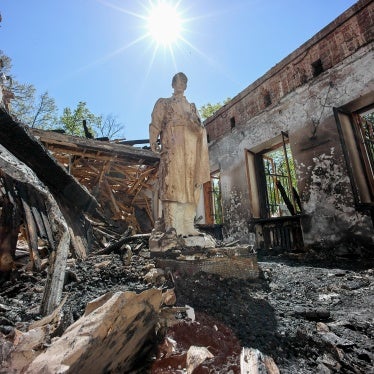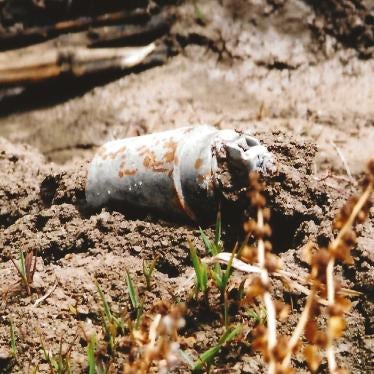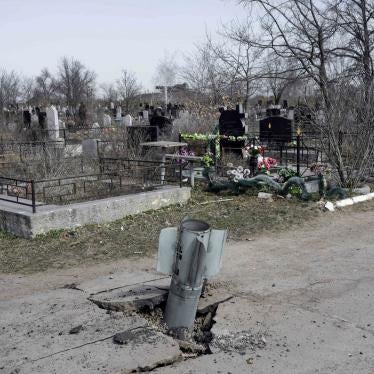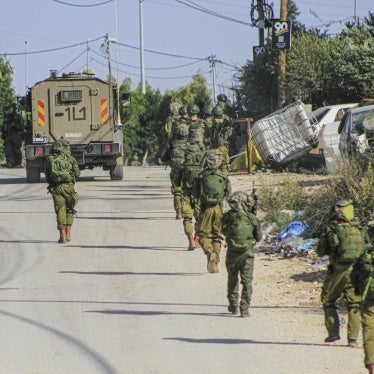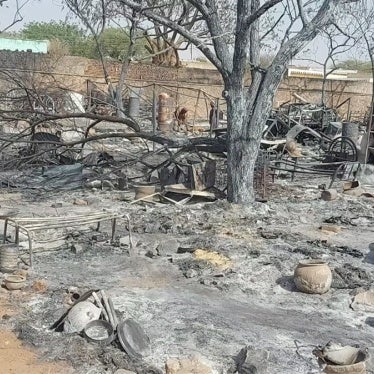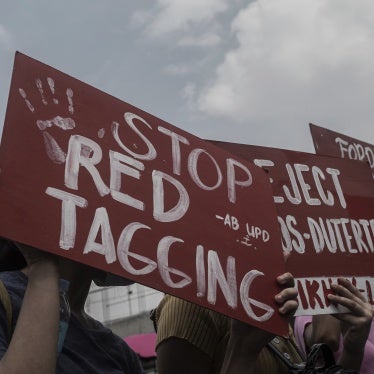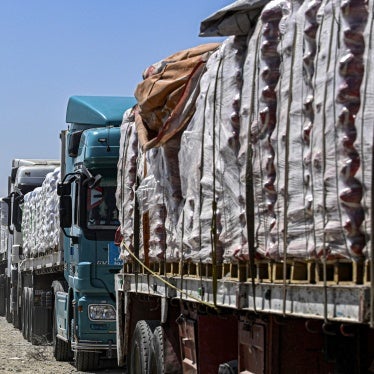Introduction
Since Russia’s full-scale invasion of Ukraine on February 24, 2022, Russian armed forces have used cluster munitions in attacks that have caused hundreds of civilian casualties and damaged civilian objects, including homes, hospitals, and schools. The Ukrainian military has not denied credible evidence of its own use of cluster munitions in the conflict and has publicly asked to be supplied with the weapon.
Cluster munitions are weapons that can be delivered by rockets, missiles, and aircraft. They open in mid-air and disperse dozens and even hundreds of smaller submunitions, also called bomblets, over an area the size of a city block. Many submunitions fail to explode on initial impact, leaving duds that act like landmines, posing a threat to civilians for years and even decades.
The 2008 Convention on Cluster Munitions comprehensively prohibits these weapons due to their indiscriminate effects and the long-lasting danger that they pose.[1] It requires the destruction of stockpiles, clearance of areas contaminated by cluster munitions remnants, and assistance to victims. Russia and Ukraine are not among the treaty’s 111 states parties. Nonetheless, the use of cluster munitions in populated areas invariably violates international humanitarian law prohibitions on the use of weapons that cannot discriminate between civilians and combatants.[2]
This briefing paper presents the types of cluster munitions being used in the international armed conflict in Ukraine in 2022 and 2023. It provides examples of civilian harm from cluster munitions since our last summary report, issued in May 2022.[3] Finally, the paper charts the policy positions of Russia, Ukraine, and the international community on the use of cluster munitions in Ukraine.
Recommendations
To the parties to the conflict in Ukraine
- Immediately cease the use of cluster munitions and withdraw them from operational service; and
- Accede to the Convention on Cluster Munitions.
To all governments
- Urge Russia and Ukraine to stop using cluster munitions and encourage them to accede to the Convention on Cluster Munitions;
- Use every opportunity to condemn the use of cluster munitions in Ukraine, including via joint statements and resolutions;
- Commit to not assisting Russia or Ukraine with any activities prohibited under the convention, such as the use and transfer of cluster munitions; and
- Urge all states to accede to the Convention on Cluster Munitions without delay.
Methodology
This briefing paper draws on a range of information collected by Human Rights Watch and other organizations, including:
- Visits to the locations of cluster munition attacks;
- Interviews with witnesses to cluster munition attacks in Ukraine, as well as with medical personnel, local authorities, deminers, and others;
- Videos and photos, obtained directly or via social media, showing the remnants of cluster munitions and submunitions as well as impact damage at the site of attacks;
- Satellite imagery analysis of areas that came under attack;
- Displays of cluster munition remnants cleared by government authorities and deminers;
- Reporting by domestic and international media, specialized military analysts, humanitarian demining operators, and human rights organizations; and
- Munitions technical reference guides maintained by the Geneva International Centre for Humanitarian Demining (GICHD), Collective Awareness to UXO (CAT-UXO.com), Fenix Insight, Jane’s Information Group, Armament Research Services (ARES), and Russia Military Parade. Of particular utility for ordnance identification is GICHD’s “Explosive Ordnance Guide for Ukraine,” second-edition guide.[4]
This briefing paper does not provide a comprehensive record of civilian harm from cluster munition attacks in Ukraine as the continued hostilities makes it challenging to provide a country-wide assessment of impacted areas and communities. It also does not address the use of remotely delivered landmines or incendiary submunitions as these weapons are addressed by other instruments of international humanitarian law.
Human Rights Watch welcomes corrections and further information.
Types of Cluster Munitions
At least 10 types of cluster munitions and three types of individual submunitions have been used in Ukraine since February 24, 2022. They are all launched from the ground in missiles, rockets, and mortar projectiles except for the RBK-series cluster bomb, which is delivered by aircraft. With the exception of an Israeli-designed cluster munition, the cluster munitions used in Ukraine were manufactured in the Soviet Union prior to 1991 or in Russia, some as recently as 2021.
|
Submunition Type |
Delivery weapon type (and quantity of submunitions) |
Notes |
|
Ground-fired Rockets and Missiles |
||
|
9N210/9N235 fragmentation |
9M27K-series Uragan rocket (30) |
Both Russia and Ukraine stockpile this type and have used them since February 2022. Russian and Ukrainian forces also used this type in the 2014-2015 conflict in eastern Ukraine. |
|
9N210/9N235 fragmentation |
9M55K-series Smerch rocket (72) |
Both Russia and Ukraine stockpile this type and have used them since February 2022. Russian and Ukrainian forces also used this type in the 2014-2015 conflict in eastern Ukraine. |
|
3B30 dual-purpose* |
9M544 Tornado-S guided missile (552) |
This newly produced type of cluster munition is only possessed and used by Russia. It is difficult to distinguish between remnants of the 9M544 and the 9M549 rockets with the information currently available.[5] |
|
9N235 fragmentation |
9M549 Tornado-S guided missile (72) |
This newly produced delivery system is only possessed and used by Russia. It is difficult to distinguish between remnants of the 9M544 and the 9M549 rockets with the information currently available. |
|
9N24 fragmentation |
9M79-series Tochka ballistic missile (50) |
Both Russia and Ukraine stockpile variants of the Tochka ballistic missile with a cluster munition warhead.[6] Russia’s claims that it has withdrawn the missile from its service are not credible and are refuted by photographs of the system and auxiliary components present in Ukraine. |
|
9N730 dual-purpose* |
9M723K1 Iskander ballistic missile (54) |
This newly produced cluster munition is only possessed and used by Russia.[7] |
|
Ground-fired Artillery and Mortar Projectiles |
||
|
O-16 fragmentation |
3-O-14 203mm artillery projectile (24) |
Both Russia and Ukraine stockpile this type of cluster munition. Ukrainian artillery units have posted videos to social media showing them firing these cluster munition projectiles.[8] |
|
O-16 fragmentation |
3-O-13 152mm artillery projectile (8) |
Both Russia and Ukraine stockpile this type of cluster munition.[9] While it was photographed in the combat zone, it is not clear whether it was used. |
|
O-10 fragmentation |
3-O-8 240mm mortar projectile (14) |
Only Russia stockpiles this type of cluster munition, which uses a small white parachute for stabilization during its descent.[10] While it was photographed in the combat zone, it is not clear whether it was used. |
|
M87 dual-purpose* |
M971 120mm mortar projectile (24) |
Photographed in possession of Ukrainian armed forces. Israel originally produced this type of cluster munition, but it is not known how or from whom Ukraine acquired it. Russia is not known to stockpile M971 120mm cluster munition mortar projectiles. |
|
Air-dropped Bombs |
||
|
PTAB-1M fragmentation |
RBK-500 PTAB-1M bomb (268) |
Both Russia and Ukraine stockpile this type of cluster munition and dud submunitions and remnants of the bomb that delivered them have been documented in the Odeska region.[11] |
|
ShOAB-0.5 fragmentation |
Not known |
Individual submunitions of this type have been photographed in the Donetska region.[12] |
|
PTAB-2.5 dual purpose* |
Not known |
Individual submunitions of this type have been photographed being modified for use in drone-dropped munitions. |
Civilian Harm from Cluster Munitions
The exact number of cluster munition attacks thus far in the 2022-2023 conflict is not known, but hundreds have been documented, reported, or credibly alleged, mostly in populated areas. At least 10 of the country’s 24 regions (oblasts) have been affected by the use of cluster munitions: Chernihivska, Dnipropetrovska, Donetska, Kharkivska, Khersonska, Luhanska, Mykolaivska, Odeska, Sumska, and Zaporizka. Ukrainian Prime Minister Denys Shmyhal stated in April 2023 that about 174,000 square kilometers of Ukrainian land is now contaminated with explosive objects, which killed 226 people in the month of March 2023 alone.[13]
The cluster munition attack with the highest known civilian casualties occurred on April 8, 2022, when Russia launched a Tochka-U ballistic missile equipped with a cluster munition warhead at a crowded train station in the eastern city of Kramatorsk as hundreds of people were trying to leave the area. A detailed Human Rights Watch investigation found that the attack killed at least 58 civilians and injured over 100 others.[14]
The following cluster munition attacks since May 2022 were predominately undertaken by Russian forces and demonstrate civilian harm from these weapons.[15]
- Russian armed forces used cluster munition rockets in attacks on Kharkiv city and nearby areas in Kharkivska region in May 2022 according to an investigation by Human Rights Watch.[16] Two volunteers were wounded on May 12 when a cluster munition rocket pierced the roof of a cultural center in Derhachi, near Kharkiv city. Two civilians about a kilometer away were killed, at around the same time, by submunitions – possibly from the same rocket. On May 23, a cluster munition attack struck a maternity clinic in Kharkiv city, wounding a man at a bus stop outside the clinic.
- Ukrainian armed forces reportedly used cluster munitions in attacks on Izium city, Kharkivska region, between March and September 2022, when it was controlled by Russian armed forces, according to the Independent Commission of Inquiry on Ukraine.[17] The commission provided three examples illustrating this use of cluster munitions in Izium: a May 9, 2022 an attack on a residential area that killed three people and injured six; a July 14, 2022 attack on the central market that injured two older women; and, a July 16, 2022 attack on a residential area that killed two older persons.
- Uragan cluster munition rocket attacks by Russian forces on the city of Sloviansk on June 27, 2022 killed a man and wounded three other civilians, according to Agence France Presse.[18]
- Russian armed forces used cluster munitions in an attack on city of Kryvyi Rih in Dnipropetrovska region on July 9, 2022, killing two civilian women and wounding a civilian man, according to a statement by the Dnipropetrovska region Prosecutor's Office.[19]
- A Russian attack using Uragan cluster munition rockets killed a 70-year-old man and wounded two civilian women in an apartment building in Chuhuiv city, Kharkivska region on August 3, 2022, according to local authorities.[20]
- A cluster munition rocket attack by Russian forces reportedly killed two civilians and wounded 12 others near a public transportation stop in Mykolaiv on September 29, 2022, according to local authorities.[21]
- Russian armed forces used cluster munitions rockets in at least three attacks on Kherson city in November 2022, according to Human Rights Watch.[22] One attack wounded three people as they were walking down a city street on November 21.
- An Uragan cluster munition rocket attack by Russian forces on the town of Hirnyk, Donetska region on December 12 killed two civilians and wounded 10 more, according to the Prosecutor General’s Office.[23]
- Russian forces fired Uragan cluster munition rockets near the central market in the town of Konstyantynivka in Donetska region on March 18, 2023, wounding at least six civilians, according to the region’s governor.[24] That same day, Russian forces used cluster munitions in an attack on the city of Kramatorsk, which killed at least two people and wounded eight.[25]
- A Russian cluster munition attack on the village of Malokaterynivka in eastern Ukraine on May 10 wounded eight people including three emergency medical workers, according to the governor of Zaporizka region.[26]
Russia's Response
The Russian government has generally avoided commenting on its use of cluster munitions in Ukraine but has not denied using the weapons. Instead, it has sought to draw attention to past use of cluster munitions by, for example, NATO member states in Yugoslavia in 1999.[27]
After the April 8, 2022, Russian cluster munition attack on the Kramatorsk train station, the Russian Defense Ministry blamed Ukraine for the attack.[28] Russian Foreign Minister Sergei Lavrov repeated the unsubstantiated claim on April 20.[29]
Russia and its proxy forces previously used cluster munitions in eastern Ukraine in 2014 until a 2015 ceasefire, causing numerous civilian casualties.[30] Russia repeatedly drew attention to Ukraine’s use of cluster munitions at the time, but never acknowledged its role in using cluster munitions. Russia has never explicitly denied its direct involvement in supporting the Syrian government’s cluster munition attacks since 2015, which Russian Foreign Minister Lavrov told Human Rights Watch in 2016 were carried out in compliance with international humanitarian law.[31]
Russia is the most vocal state critic of the Convention on Cluster Munitions, which it says it cannot join as it regards cluster munitions as “a legitimate type of weapon that is not banned by international humanitarian law and plays a significant role in the defense interests of Russia.”[32] Russia last participated as an observer in a meeting of the convention in 2012.
Ukraine’s Response
Ukraine has not denied credible evidence of its own use of cluster munitions in the current conflict. The New York Times was the first to report Ukrainian cluster munition use. It found evidence that strongly suggested that Ukrainian forces used Uragan cluster munition rockets in Husarivka in Kharkivska region on March 6 or 7, 2022 when Russian forces occupied the village.[33] The New York Times published the following response from Ukraine’s military:
The Armed Forces of Ukraine strictly adhere to the norms of international humanitarian law. One of our constant priorities is the security of the civilian population. We do not open fire or destroy civilian objects, nor do we use weapons and methods prohibited by the Geneva Conventions.
Ukraine inherited a large stockpile of cluster munitions after the breakup of the Soviet Union and used them in the Donetska and Luhanska regions in 2014 and 2015.[34] At that time, the Ukrainian government repeatedly denied using cluster munitions and blamed the attacks on Russia-sponsored armed groups and the Russian armed forces. Ukraine reported in 2011 that cluster munitions constituted 35 percent of its stocks of conventional weapons, which totaled two million tons of ammunition.[35]
In September 2022, an unpaid US advisor to the commander in chief of the Ukraine Armed Forces, Gen. Valeriy Zaluzhnyi, wrote an article in September 2022 advising Ukraine to request dual-purpose improved conventional munition (DPICM) submunitions from US stockpiles for Ukraine to use in its 155mm artillery systems.[36] Since then, several media outlets have reported on the Ukrainian government’s requests to be supplied with cluster munitions.[37] According to US lawmakers, Ukraine has also requested MK-20 Rockeye cluster bombs – also known as CBU-99 or CBU-100.[38]
At the Munich Security Conference in February 2023, Ukraine’s deputy prime minister, Olexander Kubrakov, and foreign minister, Dmytro Kuleba, appealed for Ukraine to be supplied with cluster munitions.[39] In response, NATO Secretary-General Jens Stoltenberg told media that "NATO has neither recommended nor supplied these kinds of weapons. We supply artillery and other types of weapons, but not cluster bombs."[40]
Ukraine has not taken any steps to join the Convention on Cluster Munitions and last participated as an observer in a meeting of the convention in 2014.[41]
International Response
The Convention on Cluster Munitions obligates each state party to “promote the norms it establishes and … make its best efforts to discourage States not party to this Convention from using cluster munitions.”[42] States parties should firmly oppose any use of cluster munitions by any warring party under any circumstances.[43]
In accordance with this explicit provision and the emerging international norm, the use of cluster munitions in Ukraine been condemned by at least 40 states: Albania, Andorra, Australia, Austria, Belgium, Bosnia and Herzegovina, Canada, Chile, Costa Rica, Denmark, Estonia, Finland, France, Georgia, Germany, Greece, Guatemala, Iceland, Ireland, Italy, Latvia, Liechtenstein, Lithuania, Mexico, Republic of Moldova, Monaco, Montenegro, Netherlands, New Zealand, North Macedonia, Norway, Philippines, Poland, Romania, San Marino, Slovakia, Sweden, Switzerland, Ukraine, and the United Kingdom.[44]
The United States government has expressed deep alarm at Russia’s use of cluster munitions in Ukraine.[45] However, it backtracked on a comment from one senior US official who criticized cluster munitions as unacceptable weapons that “have no place on the battlefield.”[46] This reflects the unwillingness of the US to join the convention.
NATO Secretary-General Stoltenberg has called Russia’s use of cluster munitions in Ukraine “inhumane” and “in violation” of international law.[47] All of NATO’s 31 member states have ratified the Convention on Cluster Munitions except Estonia, Finland, Greece, Latvia, Poland, Romania, Turkey, and the United States.
The cluster munition attacks in Ukraine have also been condemned by the European Union and its member and candidate states, the UN high commissioner for human rights, and UN special rapporteurs and experts. It has also been condemned by the nongovernmental Cluster Munition Coalition, which is chaired by Human Rights Watch.
The condemnations of the use of cluster munitions in Ukraine in 2022 as well as strong media coverage and public outcry demonstrate the growing stigma against these weapons.
Turkey and Ukraine both denied an article published by a US media outlet in January 2023 that claimed Turkey—which is not a party to the convention—had transferred cluster munitions to Ukraine in November 2022.[48] The Turkish president's spokesperson, Ibrahim Kalin, denied the report and reportedly stated, “We don't have cluster munitions and we haven't provided them to Ukraine.”[49] Ukraine's ambassador to Turkey, Vasyl Bodnar, denied the alleged transfer as “Russian propaganda.”[50]
States that have joined the Convention on Cluster Munitions are prohibited from assisting, encouraging, or inducing anyone to engage in any activity banned under the convention. Therefore, any NATO or other military operation in support of Ukraine in which states parties participate could not assist with the use or transfer of cluster munitions. In addition, states parties may not transfer any remaining cluster munitions that have retained or have yet to destroy to Ukraine due to the convention’s prohibition on transfer.
Germany’s defense minister, Boris Pistorius, said in February 2023 that “Germany won’t authorize the transfer of cluster bombs to Ukraine.”[51] He was responding to media reports claiming that Estonia was considering providing Ukraine with German-made 155mm DM632 cluster munition projectiles.[52] Such a transfer requires approval of the German government.
Additional Information
For more Human Rights Watch reporting on cluster munitions in Ukraine, see:
“Ukraine: Russian Cluster Munition Hits Hospital,” February 25, 2022, https://www.hrw.org/news/2022/02/25/ukraine-russian-cluster-munition-hits-hospital.
“Ukraine: Cluster Munitions Launched Into Kharkiv Neighborhoods,” March 4, 2022, https://www.hrw.org/news/2022/03/04/ukraine-cluster-munitions-launched-kharkiv-neighborhoods.
“Ukraine: Cluster Munitions Repeatedly Used on Mykolaiv,” March 17, 2022, https://www.hrw.org/news/2022/03/17/ukraine-cluster-munitions-repeatedly-used-mykolaiv.
Intense and Lasting Harm: Cluster Munition Attacks in Ukraine, May 11, 2022, https://www.hrw.org/report/2022/05/11/intense-and-lasting-harm/cluster-munition-attacks-ukraine.
“Ukraine: Russian Strikes Killed Scores of Civilians in Chernihiv,” June 10, 2022, https://www.hrw.org/news/2022/06/10/ukraine-russian-strikes-killed-scores-civilians-chernihiv.
"Ukraine: Unlawful Russian Attacks in Kharkiv," August 16, 2022,” https://www.hrw.org/news/2022/08/16/ukraine-unlawful-russian-attacks-kharkiv.
“Growing Civilian Toll from Russian Cluster Munition Attacks,” August 25, 2022, https://www.hrw.org/news/2022/08/25/growing-civilian-toll-russian-cluster-munition-attacks.
“Ukraine: Apparent Cluster Munition Hit Kherson,” December 13, 2022, https://www.hrw.org/news/2022/12/13/ukraine-apparent-cluster-munitions-hit-kherson.
“Ukraine: New Light on Russia’s Rail Station Attack,” February 21, 2023, https://www.hrw.org/news/2023/02/21/ukraine-new-light-russias-rail-station-attack.
[1] Convention on Cluster Munitions, adopted May 30, 2008, Dublin Diplomatic Conference for the Adoption of a Convention on Cluster Munitions, CCM/77, entered into force August 1, 2010, https://www.clusterconvention.org/.
[2] See Protocol Additional to the Geneva Conventions of 12 August 1949, and relating to the Protection of Victims of International Armed Conflicts (Protocol I), June 8, 1977, article 51(4). Both Russia and Ukraine are parties to Protocol I.
[3] Human Rights Watch, Intense and Lasting Harm: Cluster Munition Attacks in Ukraine, May 11, 2022. https://www.hrw.org/report/2022/05/11/intense-and-lasting-harm/cluster-munition-attacks-ukraine.
[4] Geneva International Centre for Humanitarian Demining (GICHD), Explosive Ordnance Guide for Ukraine, 2nd edition, September 2022, https://www.gichd.org/en/resources/publications/detail/publication/explosive-ordnance-guide-for-ukraine-second-edition/ (accessed May 9, 2023).
[5] Jake Godin (@JakeGodin), Twitter, “More images of 3B30 submunitions via the Dnipropetrovsk SES shared on Facebook. They say they destroyed 37 UXO found near Velyka Kostromka today and 41 UXO near Velykomykhailivka yesterday,” September 15, 2022, https://twitter.com/JakeGodin/status/1570492844225474567?s=20 (accessed May 24, 2023).
[6] EOD205 (@eod205), Twitter, “32 9N24 submunitions were secured by DSNS deminers following a crash of Tochka 9M79 tactical ballistic missile of the 9N123K series cargo. Near the village of Dytyatky in the Vyshhorod region north of Kiev,” January 19, 2023, https://twitter.com/eod205/status/1616191037071818752?s=20 (accessed May 24, 2023).
[7] Jake Godin (@JakeGodin), Twitter, “Another image from the October 5 incident in Zaporizhzhia region shows 9N730 submunitions from the 9M723k1 (small correction: Iskander-K is a misnomer) that was reportedly shot down,” October 13, 2022, https://twitter.com/JakeGodin/status/1580571117462298625?s=20 (accessed May 24, 2023).
[8] Ukraine Weapons Tracker (@UAWeapons), Twitter, “#Ukraine: A powerful Ukrainian 2S7 Pion 203mm self-propelled howitzer seen firing a rare 3014 cluster projectile, each of which dispenses 24 1.3kg HE FRAG submunitions. There is a ~90 meter kill radius for uncovered standing targets, at ranges of up to 30km,” October 18, 2022, https://twitter.com/UAWeapons/status/1582459723814961152?s=20 (accessed May 24, 2023).
[9] Main Office of the State Emergency Service of Ukraine in the Kherson region, Facebook post, November 11, 2022, https://www.facebook.com/DSNSKHERSON/posts/pfbid0G4wwVbuM4ECopbYFwY79t2odFJgrx9i4BNk9K8U2U5x2u1Hoe5r32Qict1JhKtuql (accessed May 24, 2023).
[10] Seveer of the 95th rifles (@Seveerity), Twitter, “I don’t know if this is live, or a spent casing, regardless, very brave,” April 5, 2023, https://twitter.com/Seveerity/status/1643555787543855104?s=20 (accessed May 24, 2023).
[11] CIT (en) (@CITeam_en), Twitter, “We have extensively covered the use of Russian cluster bombs in Syria, and now we are seeing them in Ukraine. This video from Ukraine's emergency service, filmed in Odesa region, shows the remains of RBK-500 cluster bomb and PTAB-1M submunitions,” March 5, 2022, https://twitter.com/CITeam_en/status/1500053731668369408?s=20 (accessed May 25, 2023).
[12] “‘We’re going back to Bakhmut’- how medevac works in the epicenter of battle for Donbas,” Hromadske, YouTube, April 19, 2023, https://youtu.be/t_OAI2XbpO4 (accessed May 24, 2023).
[13] Statement by Prime Minister Denys Shmyhal at a Government session, Communications Department of the Secretariat of the Cabinet of Ministers of Ukraine, April 4, 2023, https://www.kmu.gov.ua/en/news/promova-premier-ministra-ukrainy-denysa-shmyhalia-na-zasidanni-uriadu-04042023 (accessed April 26, 2023).
[14] Human Rights Watch, “Ukraine: New Light on Russia’s Rail Station Attack,” February 21, 2023, https://www.hrw.org/news/2023/02/21/ukraine-new-light-russias-rail-station-attack.
[15] For a list of instances or allegations of cluster munition use in the conflict prior to May 2022, see Human Rights Watch, Intense and Lasting Harm: Cluster Munition Attacks in Ukraine, May 11, 2022, https://www.hrw.org/report/2022/05/11/intense-and-lasting-harm/cluster-munition-attacks-ukraine.
[16] Human Rights Watch, “Russian Cluster Munition Use in Kharkiv,” August 16, 2022, https://www.hrw.org/news/2022/08/16/ukraine-unlawful-russian-attacks-kharkiv.
[17] Report of the Independent International Commission of Inquiry on Ukraine, Human Rights Council, 52nd session, March 15, 2023, https://www.ohchr.org/sites/default/files/documents/hrbodies/hrcouncil/coiukraine/A_HRC_52_62_AUV_EN.pdf (accessed May 9, 2023).
[18] “Blood and fears as Russian missile hits flats in east Ukraine city,” Digital Journal, June 27, 2022. https://www.digitaljournal.com/world/blood-and-fears-as-russian-missile-hits-flats-in-east-ukraine-city/article (May 9, 2023).
[19] “Missile attack on Kryvyi Rih: A kindergarten worker and a 20-year-old athlete were killed – proceedings have been launched,” Dnipropetrovsk region Prosecutor's Office, July 10, 2022, https://dnipr.gp.gov.ua/ua/news.html?_m=publications&_c=view&_t=rec&id=316061&fbclid=IwAR12eIACWDaCBi5d4R4MVqiSIH4YKGeDFzlBRRXKz-m8rh9niQoN8afitVU (accessed May 9, 2023).
[20] “Russia attacks apartment block in Chuhuiv: two people injured and one person killed,” Pravda Ukraine, August 3, 2022. https://news.yahoo.com/russia-attacks-apartment-block-chuhuiv-125431041.html (accessed May 9, 2023).
[21] “Cluster munition attack on Mykolaiv: explosion near bus stop, injured people reported,” Pravda Ukraine, September 29, 2022. https://www.pravda.com.ua/eng/news/2022/09/29/7369681/ (accessed May 9, 2023).
[22] Human Rights Watch, “Cluster Munition Attacks Hit Kherson,” December 13, 2022, https://www.hrw.org/news/2022/12/13/ukraine-apparent-cluster-munitions-hit-kherson.
[23] “Two civilians killed, ten injured in Russian attack on Hirnyk, Ukrinform, December 12, 2023, https://www.ukrinform.net/rubric-ato/3632626-two-civilians-killed-ten-injured-in-russian-attack-on-hirnyk.html (accessed May 9, 2023).
[24] “Governor: 6 civilians wounded by cluster munitions in Kostiantynivka,” The Kyiv Independent, March 18, 2023, https://kyivindependent.com/governor-6-civilians-wounded-by-cluster-munitions-in-konstyantynivka/ (accessed May 9, 2023).
[25] “Local authorities: Russian forces use cluster munition to shell Ukraine’s Donetsk region, two killed,” Novaya Gazeta Europe, March 18, 2023, https://novayagazeta.eu/articles/2023/03/18/local-authorities-russian-forces-use-cluster-munition-to-shell-ukraines-donetsk-region-two-killed-en-news (accessed May 9, 2023).
[26] “Invaders use cluster munitions in Zaporizhzhya Oblast, injuries and destruction reported,” The New Voice of Ukraine, May 11, 2023, https://news.yahoo.com/invaders-cluster-munitions-zaporizhzhya-oblast-112700636.html (accessed May 9, 2023).
[27] Statement by Ambassador Gennady Gagtilov, Permanent Representative of the Russian Federation to the UN Office and Other International Organizations in Geneva during the 49th Session of the UN Human Rights Council, March 3, 2022, https://geneva.mid.ru/en_US/web/geneva_en/human-rights-and-humanitarian-issues/-/asset_publisher/Gx3Med4zxBAF/content/statement-by-ambassador-gennady-gatilov-during-urgent-debates-on-the-situation-in-ukraine-49-th-session-of-the-un-human-rights-council-march-3-2022-ge?inheritRedirect=false&redirect=https%3A%2F%2Fgeneva.mid.ru%3A443%2Fen_US%2Fweb%2Fgeneva_en%2Fhuman-rights-and-humanitarian-issues%3Fp_p_id%3D101_INSTANCE_Gx3Med4zxBAF%26p_p_lifecycle%3D0%26p_p_state%3Dnormal%26p_p_mode%3Dview%26p_p_col_id%3Dcolumn-1%26p_p_col_count%3D1 (accessed May 5, 2022); See also, Human Rights Watch, NATO’s Use of Cluster Munitions in Yugoslavia, May 11, 1999, https://www.hrw.org/report/1999/05/11/natos-use-cluster-munitions-yugoslavia.
[28] Ministry of Defence of the Russian Federation, April 8, 2022, post to Telegram channel, https://t.me/mod_russia_en/761 (accessed September 1, 2022).
[29] “Interview with the Minister of Foreign Affairs of the Russian Federation, S.V. Lavrov for Indian Television Channel ‘India Today,’ Moscow, April 19, 2022” (“Интервью Министра иностранных дел Российской Федерации С.В.Лаврова индийскому телеканалу «Индия Тудэй», Москва, 19 апреля 2022 года”), Embassy of the Russian Federation in the United Kingdom and Northern Ireland, April 20, 2022, https://rus.rusemb.org.uk/article/658 (accessed September 1, 2022).
[30] Human Rights Watch, Technical Briefing Note: Cluster Munition Use in Ukraine, June 22, 2015, https://www.hrw.org/news/2015/06/22/technical-briefing-note-cluster-munition-use-ukraine.
[31] Letter from Sergey Lavrov, Russian Foreign Minister to Human Rights Watch and annexed position paper on “Russia’s Position on the Use of Cluster Munitions in Syria,” December 6, 2016, https://www.hrw.org/sites/default/files/supporting_resources/pdf_for_publication_0.pdf. See also, letter from Human Rights Watch to the Russian Foreign Minister Sergey Lavrov regarding cluster munitions in Syria, August 10, 2016, https://www.hrw.org/news/2016/08/10/letter-russian-minister-foreign-affairs-sergey-lavrov-regarding-cluster-munitions.
[32] “Russia explains refusal to join cluster bombs convention,” Interfax: Russia & CIS Military Newswire, December 8, 2008. Similar language was used in a September 2009 letter to the Cluster Munition Coalition (CMC). See letter from Sergey Ryabkov, Ministry of Foreign Affairs, to the CMC, September 18, 2009. Unofficial translation by the Russian Ministry of Foreign Affairs. Cited in Cluster Munition Coalition, “Russia Ban Policy Profile,” Cluster Munition Monitor 2021, http://www.the-monitor.org/en-gb/reports/2021/russian-federation/cluster-munition-ban-policy.aspx (accessed May 9, 2022).
[33] Thomas Gibbons-Neff and John Ismay, “To Push Back Russians, Ukrainians Hit a Village With Cluster Munitions,” New York Times, April 18, 2022, https://www.nytimes.com/2022/04/18/world/europe/ukraine-forces-cluster-munitions.html#:~:text=%E2%80%9CThe%20Armed%20Forces%20of%20Ukraine,prohibited%20by%20the%20Geneva%20Conventions.%E2%80%9D (accessed May 5, 2022).
[34] Human Rights Watch, Technical Briefing Note: Cluster Munition Use in Ukraine, June 22, 2015, https://www.hrw.org/news/2015/06/22/technical-briefing-note-cluster-munition-use-ukraine.
[35] Of the cluster munitions, 34% were produced before 1980, while 36% were produced between 1981 and 1992 and were “planned to be stockpiled and might be used.” The remaining 30% comprised of antivehicle landmines “Impact of the CCW Draft Protocol VI (current version) on Ukraine’s Defense Capability,” presentation of Ukraine to the CCW-GGE on Cluster Munitions, Geneva, April 1, 2011, Slide 2.
[36] Dan Rice, “Give Ukraine the ‘right artillery ammo’: DPICM,” Small Wars Journal, September 8, 2022, https://smallwarsjournal.com/jrnl/art/give-ukraine-right-artillery-ammo-dpicm (May 9, 2023).
[37] See, for example, Jack Detsch, “Ukraine Says It Needs More Guns, Shells, and Firepower,” Foreign Policy, October 26, 2022, https://foreignpolicy.com/2022/10/26/ukraine-weapons-request-firepower-russia-war/ (accessed May 9, 2023).
[38] Jonathan Landay, “Exclusive: Ukraine seeks US cluster bombs to adapt for drone use – lawmakers,” Reuters, March 6, 2023, https://www.reuters.com/world/europe/ukraine-seeks-us-cluster-bombs-adapt-drone-use-lawmakers-2023-03-06/ (accessed May 9, 2023).
[39] Kubrakov said, “Russia is using cluster munitions every day. Our people are dying. Why can’t we receive and use such weapons? The US has millions of rounds, which we want. It’s complicated with conventions, but we can use such weapons.” See: “Spotlight: Ukraine,” Munich Security Conference, February 18, 2023, https://securityconference.org/en/msc-2023/agenda/event/spotlight-ukraine/. See also: “NATO Secretary General rejects Ukraine's demand for cluster munitions,” Ukrainska Pravda, February 18, 2023. https://www.yahoo.com/entertainment/nato-secretary-general-rejects-ukraines-171701361.html (accessed May 9, 2023).
[40] “NATO Secretary General rejects Ukraine's demand for cluster munitions,” Ukrainska Pravda, February 18, 2023. https://www.yahoo.com/entertainment/nato-secretary-general-rejects-ukraines-171701361.html (accessed May 9, 2023).
[41] Cluster Munition Coalition, “Ukraine Ban Policy Profile,” Cluster Munition Monitor 2021, http://www.the-monitor.org/en-gb/reports/2021/ukraine/cluster-munition-ban-policy.aspx (accessed May 9, 2022).
[42] Convention on Cluster Munitions, Dublin Diplomatic Conference on Cluster Munitions, adopted May 30, 2008, CCM/77, entered into force August 1, 2010, art. 21(2).
[43] Human Rights Watch, The Case for Condemnation: Denouncing All Use of Cluster Munitions, April 19, 2021, https://www.hrw.org/news/2021/04/19/case-condemnation.
[44] These states have condemned the use of cluster munition in Ukraine in national or joint statements at UN bodies including the Human Rights Council, General Assembly, and Security Council, as of May 9, 2022.
[45] Statement by Ambassador Sheba Crocker, Permanent representative of the US to the UN and Other International Organizations in Geneva, at the Human Rights Council urgent debate on the human rights situation in Ukraine, March 3, 2022, https://geneva.usmission.gov/2022/03/03/hrc-49-urgent-debate-on-human-rights-situation-in-ukraine/ (accessed May 5, 2022).
[46] CSPAN, Twitter, “@USAmbUN Linda Thomas-Greenfield at the #UNGA: ‘Now, at more than any other point in recent history, the United Nations is being challenged. If the United Nations has any purpose, it is to prevent war, it is to condemn war, to stop war. That is our job here today,” March 2, 2022, https://twitter.com/cspan/status/1499058993985167362 (accessed May 5, 2022).
[47] Press conference by NATO Secretary General Jens Stoltenberg following the Extraordinary Meeting of NATO Ministers of Foreign Affairs, March 4, 2022, https://www.nato.int/cps/en/natohq/opinions_192739.htm (accessed May 5, 2022).
[48] Jack Detsch and Robbie Gramer, “Turkey Is Sending Cold War-Era Cluster Bombs to Ukraine,” Foreign Policy, January 10, 2023. https://foreignpolicy.com/2023/01/10/turkey-cold-war-cluster-bombs-ukraine/ (May 9, 2023).
[49] Ragip Soylu, “Russia-Ukraine war: Turkey denies supplying Kyiv with cluster munitions,” Middle East Eye, January 14, 2023. https://www.middleeasteye.net/news/turkey-russia-ukraine-denies-supplying-cluster-munitions (May 9, 2023).
[50] Mustafa Devici, “Ukrainian envoy in Türkiye denies claims Ankara sending cluster bombs to Ukraine,” Anadolu News Agency, January 11, 2023, https://www.aa.com.tr/en/europe/ukrainian-envoy-in-turkiye-denies-claims-ankara-sending-cluster-bombs-to-ukraine/2785450 (May 9, 2023).
[51] Antonia Faltermaier, “Streubomben für die Ukraine? Pistorius macht klare Ansage,” Berliner Morgenpost, February 23, 2023, https://www.morgenpost.de/kultur/tv/article237735065/pistorius-markus-lanz-waffen-wehrpflicht.html (accessed May 9, 2023).
[52] Madis Hindre, “Estonia weighing giving Ukraine cluster munitions,” ERR News (Estonian Public Broadcasting), January 26, 2023, https://news.err.ee/1608864767/estonia-weighing-giving-ukraine-cluster-munitions (accessed May 9, 2023).

